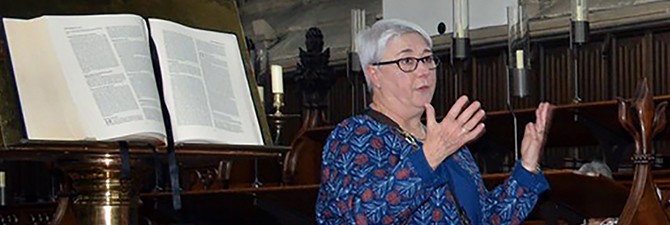
On 24 June a very privileged group of members enjoyed a fascinating study day in Oxford with Dr Sarah Brown, the Director of the York Glaziers Trust and one of this country’s leading experts on the conservation and protection of stained glass. This followed the article she had written for our Annual Review in 2016 pointing out that Oxfordshire and Oxford in particular had some of the finest glass in the country.
We began in Balliol where Sarah gave us a beautifully illustrated talk showing how the care of stained glass had matured from a rough and ready process of restoration to a science-based art of conservation.
Glass had survived the sixteenth and seventeenth centuries much better than the images within churches because even the iconoclasts recognised that glass was needed to keep the weather out. Sometimes they had just smashed the faces of the figures in the windows. Apart such vandalism damage glass suffered from poor housekeeping and from compositional decay, paint loss and deterioration caused by environmental factors above all moisture. The strategy for conservation would differ in each case. It would depend on the resources available but always required careful judgements.
To see what this meant in practice we then visited three college chapels where Sarah and the York Glaziers Trust had been active. Balliol’s chapel had been designed by William Butterfield in the mid nineteenth century but the present building is perhaps the third on the site, and the windows contain mostly C16 and C17 glass, although on the north side there are some C15 and C16 fragments. YGT had worked on the restoration of two windows on the north side of the chapel, removing the panels to the YGT workshop for cleaning and conservation. During the conservation work, a system of ventilated external protective glazing was installed.
We then went on to Merton where the chapel retains its original C13 form (without the massive nave which the founder had intended). The stained glass scheme in the chapel is exceptionally well preserved; with the nave of York Minster, it represents the largest surviving set of early C14 windows in Britain much of it the work of craftsmen in Thame. The chapel has seven pairs of windows in the side walls of the Quire. Twelve contain the original C13 figured and grisaille glass set in Decorated tracery, the remainder is C15. The heraldic glass and the Annunciation scene in the East Window are also C13. Much of the glass in the remaining windows is C15.
Finally, we visited Trinity College built entirely in the Baroque style in 1691-94. Originally designed with eight large plain glass windows. The first stained glass window was installed by the Victorians in memory of Isaac Williams (d.1865), a key figure in the Oxford Movement. Paid for by public subscription it depicts the Crucifixion. It was made in Munich by the Konigliche Glasmalereianstalt (The Royal Bavarian Stained Glass Establishment) using Flemish glass. The window was removed in 1941. It has since been reinstalled but in the antechapel where it does not detract from the harmony of the other windows.
These were re-glazed between 1885 and 1886 by the firm of James Powell and Sons (London), one of the most prolific Victorian stained glass companies. They are now a beautiful combination of plain and coloured glass, containing both religious and heraldic imagery following a scheme depicting the Virgin Mary and saints associated with the earlier medieval chapel – Cuthbert, Benedict, the Venerable Bede, St Catherine of Alexandria, St Oswald, King of Northumbria, and St Leonard. As part of the recent wonderful restoration of the chapel YGT had been commissioned to contribute to a conservation strategy for the windows which enabled them to be effectively cleaned in situ.
The workshop was three times over-subscribed by our members, and Sarah very kindly indicated that she might be able to come back and give another next year. The lucky few who had places this year would warmly recommend other members to apply. Our thanks go to Sarah Brown for sharing her wisdom and enthusiasm and to Michael Sibly and Joanna Karmowska for organizing the event.

